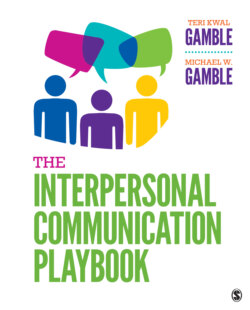Читать книгу The Interpersonal Communication Playbook - Teri Kwal Gamble - Страница 137
На сайте Литреса книга снята с продажи.
Diversity and Culture: Interpreting Through Different I’s
ОглавлениеMany persist in seeing the world not necessarily as it is but as they have been conditioned to perceive it. Culture and past experience create in us a quest for perceptual constancy—it is easier for us to keep seeing things as we have in the past than it is to revise our perceptions.
The more similar two people’s life experiences, the more similarly they tend to perceive things. The more dissimilar our life experiences, the wider the gap between us with respect to how we see and make sense of things. Cultural habits or selectivities ensure that not everyone makes sense out of experience in the same way.
The members of every culture develop particular cultural perspectives or ways of looking at the world. As we have noted, most Americans perceive it to be important to express their uniqueness and independence, whereas in Asian cultures, the group and not the individual is paramount. These contrasting orientations have implications for interpersonal communication. American children are taught to separate from their parents and develop self-reliance, but cultures that value interdependence nurture cooperation, helpfulness, and loyalty instead. Thus, people from these cultures tend to have more close-knit relationships and expect more from others.
We also see these differences play out in the processing of information. The Japanese, for example, develop a wider-angle view of experience than do Americans. They do not see themselves as being at the center of the universe. When students at the University of Michigan and Kyoto University were shown animation of an underwater scene with a “focal fish” and other fish swimming among an array of undersea objects, the Japanese students made more references to the background elements, while the Americans focused on the “focal fish.” Americans believe that each person has a separate identity that needs to be reinforced. They value the ethic of competition. This orientation can cause difficulty for Americans when they need to interact with people from other cultures who do not share this value and may perceive it as threatening.
Culture teaches us a worldview, influencing assessments of reality. Whether we are judging beauty, evaluating the meaning of success, or reacting to someone’s age, culture plays a role. In the United States, for example, we have a culture that values youth. People in Muslim, Asian, Latin American, Native American, and African cultures do not share this perception. Individuals from different cultures are simply trained to observe the same cues differently; we interpret what we perceive through a cultural lens. Some years ago, researchers used an apparatus resembling binoculars to compare the perceptual preferences of Native Americans and Mexicans. Each subject in the study was shown ten pairs of photographs; one photo in each pair was of an element of Native American culture and one was of Mexican culture. After viewing the paired images through the device, the subjects reported their observations. Results revealed that both the Native American and the Mexican subjects were more likely to report having seen scenes from their own culture.46
Race also influences perception. When it comes to views on how much progress we have made since the days of the civil rights movement, a racial divide persists. For example, when asked who will be hired, whites perceive a level playing field, whereas African Americans believe that discrimination persists. In 2015, a majority (69 percent) of African Americans, compared with 31 percent of white Americans, believed the United States needed to enact new civil right laws to reduce discrimination.47 How might such disparate perceptions affect relationships between white people and black people in the United States?
Because we have not all experienced the same life lessons, even within cultures, we may not attribute the same meanings to the same sets of conditions or behavioral cues. If we are to relate effectively to one another, we need to take steps to eliminate cultural nearsightedness.
